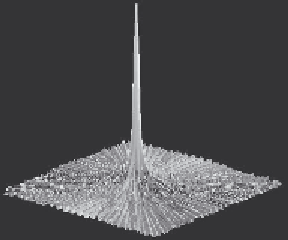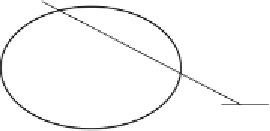Image Processing Reference
In-Depth Information
(a) Accumulator for Figure 5.11(a)
(b) Accumulator for Figure 5.11(b)
Figure 5.18
Parameter space reduction for the Hough transform for circles
By considering Equation 5.58 we have that Equation 5.48 is also valid for an ellipse. That
is,
y
() -
() -
y
0
0
=
( )
(5.60)
x
x
The geometry of the definition in this equation is illustrated in Figure
5.19
(a). As in the
case of circles, this equation defines a line that passes through the points (
x
(θ
),
y
(θ
)) and
(
x
0
,
y
0
). However, in the case of the ellipse the angles
ˆ
ˆ
( ) and ( ) are not orthogonal.
This makes the computation of φ′′ (θ ) more complex. In order to obtain φ′′ (θ ) we can
extend the geometry presented in Figure
5.17
(b). That is, we take a pair of points to define
a line whose slope defines the value of φ′ (θ ) at another point. This is illustrated in Figure
5.19
(b). The line in Equation 5.60 passes through the middle point (
x
m
,
y
m
). However, it is
not orthogonal to the tangent line. In order to obtain an expression of the HT mapping, we
will first show that the relationship in Equation 5.54 is also valid for ellipses. Then we will
use this equation to obtain φ′′ (θ ).
The relationships in Figure
5.19
(b) do not depend on the orientation or position of the
ellipse. Thus, we have that three points can be defined by
(x(
), y(
))
(x(
2
), y(
2
))
(x
T
, y
T
)
ˆ
θ
()
(x
m
, y
m
)
(x(
1
), y(
1
))
(x
0
, y
0
)
(x
0
, y
0
)
ˆ
θ
()
ˆ
()
ˆ
θ
()
(a) Relationship between angles
(b) Two point angle definition
Figure 5.19
Geometry of the angle of the first and second directional derivative





































